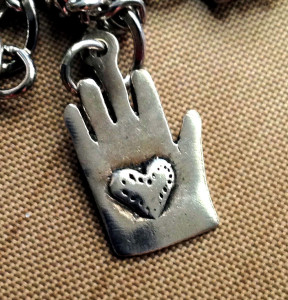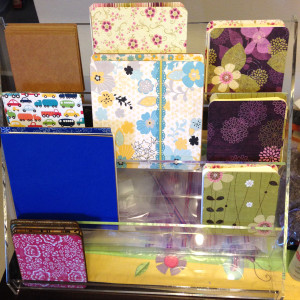I can’t help poking fun at myself—earlier today I participated on an Etsy forum where I advised a new seller that adding new products consistently to your shop is the best way to increase your business. Have I followed my own advice? Not lately. Sitting on my acrylic work-in-progress rack for more than a month have been a number of unfinished books for my shop. You may have seen this rack in a previous post, in fact.
Well, I finally finished four of the books yesterday, but not without mis-punching the holes in the yellow-and-turquoise covers that you see in the middle of the above rack. I hate when that happens! I will salvage that book, however, by cutting it down to a different size and creating a different type of book. I’ll save that for another day. But here is what I got done.
 After I finished the above books, I asked myself, “Why did it take you so long? It wasn’t that difficult.” Good question! The answer, of course, is procrastination, but what causes that? I know that for me, personally, I look around and see all of these unfinished household tasks—a stack of old clothes that need to be folded and donated, laundry that needs to be sorted and washed, a paper crafting studio that has piles of materials that need to be put away properly, dusty furniture that I could either (a) dust or (b) use as a drawing board, and then there’s the list of Web sites with potential jobs needing applications. Did I mention I’m looking for a job? Yup. It has been 26 years since I worked at a so-called traditional place of employment, but after my husband was out of work for 4+ years (he recently secured a job, though—hooray!), our retirement plan could use some beefing up. So, procrastination for me means all of this stuff is churning inside my head, distracting me from finishing projects that really don’t take that much effort to finish.
After I finished the above books, I asked myself, “Why did it take you so long? It wasn’t that difficult.” Good question! The answer, of course, is procrastination, but what causes that? I know that for me, personally, I look around and see all of these unfinished household tasks—a stack of old clothes that need to be folded and donated, laundry that needs to be sorted and washed, a paper crafting studio that has piles of materials that need to be put away properly, dusty furniture that I could either (a) dust or (b) use as a drawing board, and then there’s the list of Web sites with potential jobs needing applications. Did I mention I’m looking for a job? Yup. It has been 26 years since I worked at a so-called traditional place of employment, but after my husband was out of work for 4+ years (he recently secured a job, though—hooray!), our retirement plan could use some beefing up. So, procrastination for me means all of this stuff is churning inside my head, distracting me from finishing projects that really don’t take that much effort to finish.
But I guess I’m not alone in the procrastination game, if that’s any comfort. According to Jill Badonsky, author of The Muse is In: An Owner’s Manual to Your Creativity, “If all the unfinished projects in the world were pasted together, they would make another whole planet—but it would be an unfinished planet. Procrastination is common.” But, she counters, “Be uncommon.” Jill has a few suggestions for how to conquer procrastination, which is really a form of creative block:
 Challenge yourself to work for a set period of time, even 20 minutes, and work non-stop. Then reward yourself with five minutes of creative play, which might involve making a list or mind map of questions about your Creative Adventure, or making a list of unfinished sentences about your Creative Adventure, and then finishing the sentences. Afterward, start your challenge all over again. Why this activity works is that it creates a habit of showing up for work.
Challenge yourself to work for a set period of time, even 20 minutes, and work non-stop. Then reward yourself with five minutes of creative play, which might involve making a list or mind map of questions about your Creative Adventure, or making a list of unfinished sentences about your Creative Adventure, and then finishing the sentences. Afterward, start your challenge all over again. Why this activity works is that it creates a habit of showing up for work.
- Find yourself a work partner, even if you are in separate locations. Call each other at the beginning and end of your work times to keep both of you accountable.
- Make a creative date with yourself by taking a class that you just can’t miss because it’s so interesting. It doesn’t matter if the class is online or in person. The point is that you are setting aside time for something in which you believe, and letting that passion spill over into your work.
- If you can’t set aside time for yourself to do something creative, then donate your time to a person or cause in which you believe. What does this do? You’re exposing yourself to someone else’s passion—and passion is often contagious.
There is something to be said for how disruptive or distracting day-to-day tasks can be, however. In Ricë Freeman-Zachary’s book, Living the Creative Life, one of the artists she interviewed, dollmaker Kelly Buntin Johnson, describes a person’s mind as a cluttered dining room table. “If there are stacks of bills, to-do lists, letters and a phone strewn across the surface, how can you enjoy the delicious meal and glass of wine and chocolate cake? You have to get the day-to-day buzz out of your head before you can be receptive to creative ideas.” Kelly, who always has three or four projects going on at the same time, has a few strategies that work for her to fight the procrastination monster. The first one works especially well for me.
- Instead of staring at the project before you that obviously isn’t going to get done, at least not today, tackle a different one. This allows your subconscious to work on the first project while another part of your mind plays with other ideas.
- Take a walk (or, in my case, a shower), which is a way of taking a deep breath and getting yourself re-centered. When you’re not thinking so hard about what you should be doing, that’s precisely when your subconscious takes over, solving the issue for you.
Violette, an illustrator and art educator in British Columbia, uses a variation on the walk idea. She simply starts doodling on a blank page, and before she knows it, the doodles take on a life of their own.”The doodles tell me essentially what I want to do,” says Violette.
Or, you can simply start handling your work materials. Ricë suggests that for some people, the act of handling their art materials is all it takes to get things going. “Pick your favorite materials (crayons, clay, whatever), put them in a designated place and schedule fifteen minutes a day when you’ll work with them.” My variation on that idea is to organize my art materials. As I physically clean up a space, I open up creative space in my mind, and that helps me to overcome procrastination.
Do you have some strategies that work especially well for you in overcoming creative procrastination? Share them in the comments below.
© 2014 Judy Nolan. All rights reserved.



Yes, yes, and yes. I am in the same boat. Right now I’m trying to clean up a super cluttered messy room. Each time I do it I plan to keep it that way but before you know it both grown kids have found something they need done and I’m scrambling to accommodate them and in the process my room is utter chaos again. And no I do not want to let them help me clean it up – lol! I know I would get a lot more done if my room was tidy and somewhat organized. I do think the 15-30 minute a day helps and I need to use that “trick” more often. I have good intentions but not good follow through. I’m working on it, I’m working on it!
Good tips! I am also way behind where I’d like to be in getting new listings made, photographed and posted.
I think blocking out some time each day for “new” projects (not orders, or housework, or paperwork) might help.
My biggest problem is a to do list a mile long! But I think by writing everything down, that I can be working on something all the time. Some tasks take 5 minutes and others take an hour. If I only have a short period of time, I look for something quick on my list. But I’ve noticed that all quick tasks get done…and I need to work on those more time-consuming ones that never get done! That’s where I tend to procrastinate!
I love the analogy of the cluttered table in our heads!
Thanks for an interesting post Judy. I have had a quick look at those books on Amazon and made a note of them.
For me getting the art materials out and starting to play with them on a small study or experiment can be quite a hurdle but is one of the best ways to overcome procrastination. I can work in quite an untidy space once I have got going.